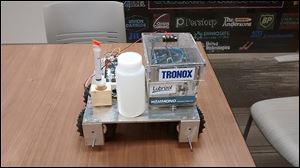
UT students in engineering place 3rd in competition
11/25/2014
American Institute of Chemical Engineers wanted to create a competition that could show what chemical engineers do.
A group of chemical engineering students from the University of Toledo recently placed third in an internationally recognized competition that challenges them to use precise chemical reactions to propel a small car a long distance with a tiny margin of error.
For nearly 20 years, the American Institute of Chemical Engineers has challenged its university chapters to build the small vehicles as part of its annual conference.
Gordon Ellis, a spokesman for the American Institute of Chemical Engineers, said the group wanted to create a kind of signature competition that could help show the public what chemical engineers actually do.
“This Chem-E-Car competition has really taken off,” Mr. Ellis said. “It’s lively, it’s gotten a lot of attention over the years.”
About the size of a standard office paper box, the UT team’s car gets its power from a homemade version of the same type of battery you’d find in your own car. The car stops by using a chemical clock to trip a light sensor that breaks the circuit.
The competition is focused on accuracy, not speed. At about a foot per second, the car creeps along at less than a mile per hour.
“The cars move very slowly. It’s not the most exciting thing to watch, but when your school is doing it and it stops right on the goal line, it’s pretty exciting,” said Jared Dupes, president of the UT chapter of the American Institute of Chemical Engineers.
Mr. Dupes said about 40 UT students traveled to Atlanta for the competition. They didn’t leave disappointed.
Just ahead of the demonstration, teams are told how far the car must travel. In this year’s case, it was 26 meters, or about 85 feet. The UT team was able to dial in its car to come to a rest within 9 centimeters of the goal.
“The iodine clock is really the key to the operation of the car,” Mr. Dupes said. “That’s how you win.”
Initially clear, the solution quickly turns to black. When that happens, the light sensor that’s suspended in the solution is set off, killing the car’s movement.
Mr. Dupes gave particular credit to team captain Scott Grekowicz and the other five team members.
Mr. Ellis said the competition has moved more into focusing on safety protocols recently.
“Safety execution is something that many of our leaders and engineers agree is something that’s not well inserted into many chemical engineering curricula at this point,” he said.
About 100 teams compete in the first round, with about 35 going on to the final round. As many as 1,500 students and 5,000 professional chemical engineers attend the annual conference itself.
Contact Tyrel Linkhorn at tlinkhorn@theblade.com or 419-724-6134 or on Twitter @BladeAutoWriter.